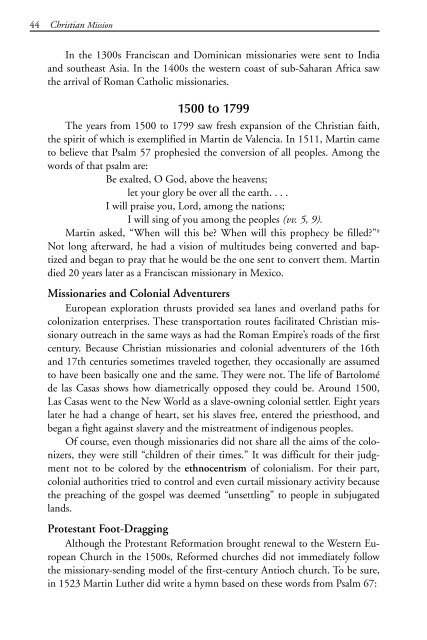discovering missions - Southern Nazarene University
discovering missions - Southern Nazarene University
discovering missions - Southern Nazarene University
You also want an ePaper? Increase the reach of your titles
YUMPU automatically turns print PDFs into web optimized ePapers that Google loves.
245187 Disc Missions ins 9/6/07 1:04 PM Page 44<br />
44 Christian Mission<br />
In the 1300s Franciscan and Dominican missionaries were sent to India<br />
and southeast Asia. In the 1400s the western coast of sub-Saharan Africa saw<br />
the arrival of Roman Catholic missionaries.<br />
1500 to 1799<br />
The years from 1500 to 1799 saw fresh expansion of the Christian faith,<br />
the spirit of which is exemplified in Martin de Valencia. In 1511, Martin came<br />
to believe that Psalm 57 prophesied the conversion of all peoples. Among the<br />
words of that psalm are:<br />
Be exalted, O God, above the heavens;<br />
let your glory be over all the earth. . . .<br />
I will praise you, Lord, among the nations;<br />
I will sing of you among the peoples (vv. 5, 9).<br />
Martin asked, “When will this be? When will this prophecy be filled?” 8<br />
Not long afterward, he had a vision of multitudes being converted and baptized<br />
and began to pray that he would be the one sent to convert them. Martin<br />
died 20 years later as a Franciscan missionary in Mexico.<br />
Missionaries and Colonial Adventurers<br />
European exploration thrusts provided sea lanes and overland paths for<br />
colonization enterprises. These transportation routes facilitated Christian missionary<br />
outreach in the same ways as had the Roman Empire’s roads of the first<br />
century. Because Christian missionaries and colonial adventurers of the 16th<br />
and 17th centuries sometimes traveled together, they occasionally are assumed<br />
to have been basically one and the same. They were not. The life of Bartolomé<br />
de las Casas shows how diametrically opposed they could be. Around 1500,<br />
Las Casas went to the New World as a slave-owning colonial settler. Eight years<br />
later he had a change of heart, set his slaves free, entered the priesthood, and<br />
began a fight against slavery and the mistreatment of indigenous peoples.<br />
Of course, even though missionaries did not share all the aims of the colonizers,<br />
they were still “children of their times.” It was difficult for their judgment<br />
not to be colored by the ethnocentrism of colonialism. For their part,<br />
colonial authorities tried to control and even curtail missionary activity because<br />
the preaching of the gospel was deemed “unsettling” to people in subjugated<br />
lands.<br />
Protestant Foot-Dragging<br />
Although the Protestant Reformation brought renewal to the Western European<br />
Church in the 1500s, Reformed churches did not immediately follow<br />
the missionary-sending model of the first-century Antioch church. To be sure,<br />
in 1523 Martin Luther did write a hymn based on these words from Psalm 67:

















